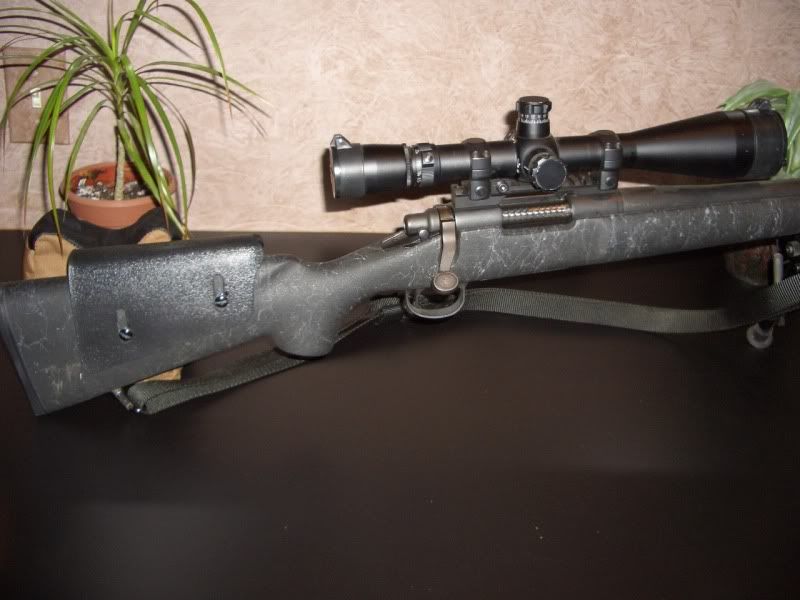Re: Can zero change 1moa going from bench to prone?
<div class="ubbcode-block"><div class="ubbcode-header">Originally Posted By: Jr_V</div><div class="ubbcode-body"><div class="ubbcode-block"><div class="ubbcode-header">Originally Posted By: Sterling Shooter</div><div class="ubbcode-body">All,
The assertion that a position change producing a hit other than where aimed is always or must be the result of inconsistent application of the fundementals is just not correct. You could say may be, but not, must be, or always.
Starting with the ARMY definition of a zero (FM 23-9): adjusting the rifle sights so bullets hit the aiming point at any given range, my score book indicates my rifle is zeroed for prone, confirmed by triangulation. In fact, a recent practice score of 198-17 suggests I've got a pinwheel X zero. In anyone's data book that would appear to be a good zero based on the result.
Now, when shooting from the standing position in identical environmental conditions, using the said prone zero, triangulation of group suggests point of impact is 3/4 minute low and 1/4 minute right. Since a blind call and plot for this group confirms the fundementals are being applied as consistently in the standing position as they were in the prone position, after all, the group is well rounded, what am I to do? I could try to re-fine the position which might get em right in there but why when shooter/target analysis suggests that I should just adjust the frigging sight to hit where aimed, which is what I indeed do.
Thing is, I do think tactical shooting, Service Rifle shooting, heck, even F class (I can't believe I said that) are the same. The only thing that could perhaps be construed to be different is the perception of the sort of perfection necessary/accessible to get the job done.
I appreciate the input of deadly0311 and memilanuk on this thread as they give a fresh perspective to an on going debate it seems I'm having with Frank on the matter. Also, as jhuskey alluded, we may both be right, as well as be contemplating what is really no big deal.</div></div>
I will state this coming from a new precision shooter so bear with me, but are you saying if my POI changes from my POA in different positions consistently and repeatably I should dial the gun to me? The gun is stupid and does what I tell it to so I would assume I should be the one doing the correcting. While playing golf I had quite a slice that I could play with very well and adapted my game to it for some time, but in the end I changed my swing to drive the ball straight because I was the problem.
It seems like if you bolted the rifle to a bench, zeroed, then bolted the rifle to the ground that its POA and POI would be the same correct? So why shouldn't the shooter replicate that rather than dicking with sight settings? I really don't get this logic at all. This sounds like correcting a "bad" habbit. (bad used for lack of better term) I know using iron sights the sight picture has to be exactly the same to maintain POA/POI and can be harder in different shooting positions, but that is where the scope helps this situation.
I guess what I am saying why do you think the rifle is the mistake and not the shooter? You say yourself that the shooter can be corrected, but you take the easy road and fix the dumb thing(rifle) instead of the shooter.</div></div>
The perception of perfect sight alignment and hold do indeed need to be consistent, and, in fact, it's only when a shooter's consistency is honed to produce a group that's real good will the zero be real good. Good groups demand consistent control of the rifle from trigger pull until recoil subsides through steady bone/artificial support. Control of the rifle in prone is like control of the rifle in other positions, in that the elements and factors of a steady position are all applied consistently. What's different however is shooter contact with the rifle. For example, as the position gets higher so does the butt stock. The non-firing hand will also have a different contact point with the stock. This change in contact with the rifle is not a mistake, it's just what it is for muscular relaxation. Since contact with the rifle is part of the zeroing equation, a change in position, in which contact with the rifle is changed as well, will effect movement of the rifle as the bullet travels though the barrel. So, even though control is maintained the divergence from recoil from one position to another, stimulated by different contact, may in effect cause point of impact to be consistently someplace other than point of aim. For this effect, you could attempt to get control of the rifle as it was when zeroed but this may not be possible, imagine supporting a rifle in the standing position as you do in the prone position. Your neck would be very uncomfortable and your non firing arm would likely be trembling so much as to produce needless wobble; and, then you'll not hit anything you're aiming at. In this case, I adjust the sight.




